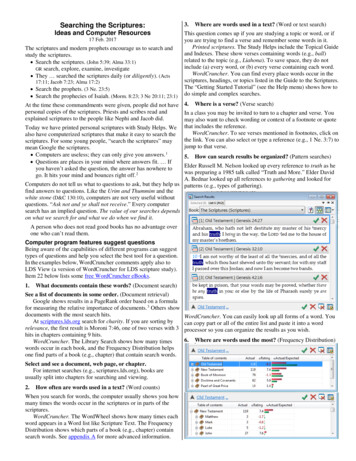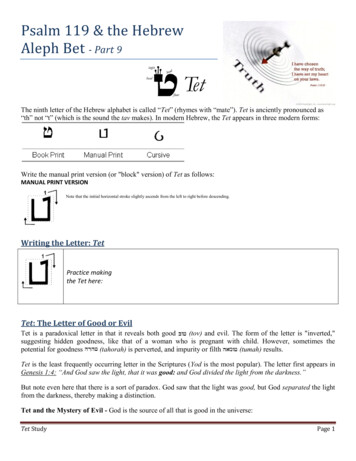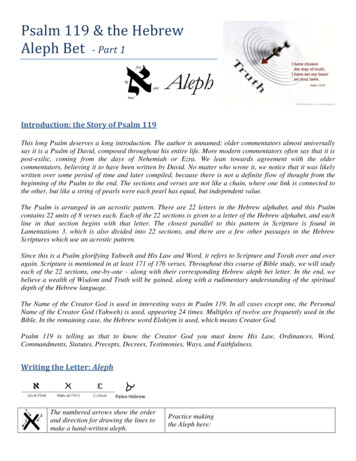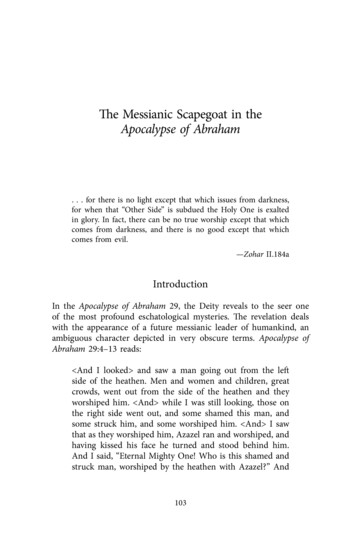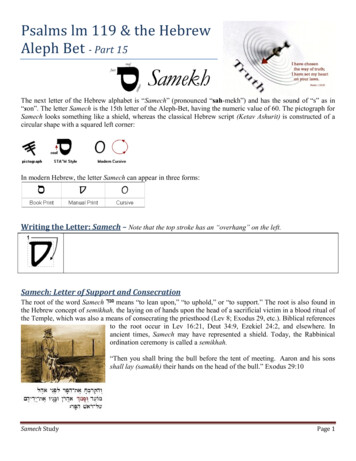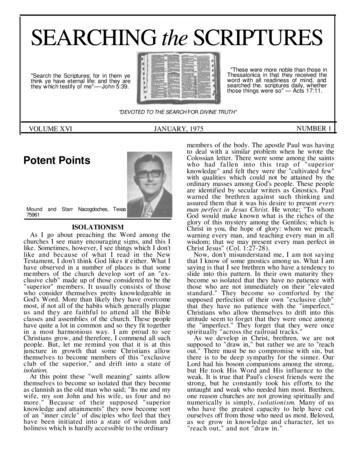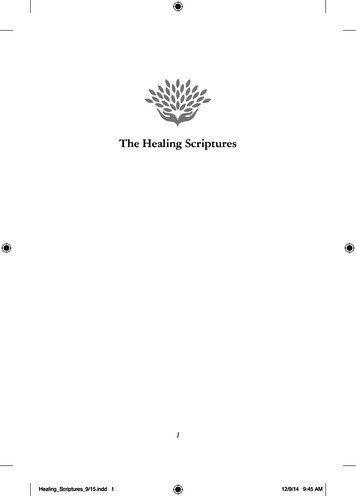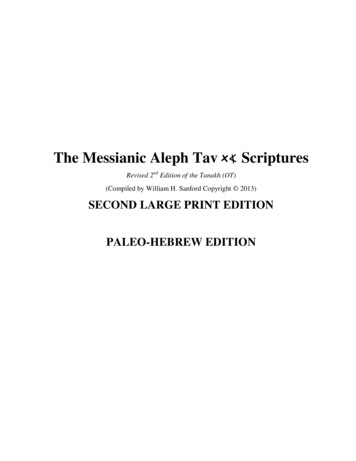
Transcription
The Messianic Aleph Tav ta ScripturesRevised 2nd Edition of the Tanakh (OT)(Compiled by William H. Sanford Copyright 2013)SECOND LARGE PRINT EDITIONPALEO-HEBREW EDITION
The Messianic Aleph Tav ta ScripturesPrinted in the USA by Snowfall PressSECOND LARGE PRINT EDITIONCopyright 2013All rights reservedWilliam H. SanfordWHSanford@aol.comCOPYRIGHT NOTICEThe Messianic Aleph Tav ta Scriptures (MATS) is an English version of the Tanakh originating from the1987 King James Bible (KJV) which is in the Public Domain. However, this rendition of the KJV restores themissing Aleph/Tav symbols throughout as well as key descriptive words which have been inserted inparenthesis to provide the reader a truer meaning of the original Hebrew text. Therefore, this work is a “StudyBible” and comes under copyright protection.This publication may be quoted in any form (written, visual, electronic, or audio), up to and inclusive ofseventy (70) consecutive lines or verses, without express written permission of William H. Sanford, providedthe verses quoted do not amount to a complete book and do not account for 10% or more of the total text ofthe work in which they are quoted. For orders please visit web address: www.AlephTavScriptures.com.Notice of copyright must appear as follows on either the title page or the copyright page of the work in whichit is being quoted as: “Scripture (or Content) taken from the Messianic Aleph Tav ta Scriptures. Copyright2013. Used with permission of William H. Sanford.” Requests for commercial or noncommercial useexceeding the above guidelines must be approved and may be directed, in writing, to William H. Sanford,(WHSanford@Aol.Com).
Isaiah 11:1 And there shall come forth a shoot out of the stock of Jesse and a Branch out of his roots shallbear fruit. And the Spirit of hWhY shall rest upon Him, the spirit of wisdom and understanding, the spirit ofcounsel and might, the spirit of knowledge and of the fear of hWhY.
DedicationThe Messianic Aleph Tav ta Scriptures is dedicated to my precious wife, Debra, and our five children,Jennifer, Jessica, Jason, Jordan, and Justin. Special appreciation to my longtime friend, Jim O’Keefe, whointroduced me to the worldwide Messianic Hebraic Roots movement in 2000.AcknowledgementsSpecial recognition to those who helped make the Messianic Aleph Tav ta Scriptures a reality Truett Haire,Carlos Mendoza, Bryan Rogers, Joey Bennett, Nancy Sikes, Steve Gustine, Ruthann Popour, Chris O’Keefe,Kevin O’Keefe, and David and Sandy Jefferson.Special Thanks and RecognitionTo Monte Judah who introduced me to the Aleph Tav and Lew White who revealed to me Babylonian Sungod worship in the churches in his book Fossilized Customs and Eric Bissell for teaching me Paleo-Hebrew.Also David Mathews, Jamie Louis, and Don Wyant for their continued encouragement and support. Specialthanks for the use of Kris Udd’s Paleo Hebrew font used by permission http://www.bibleplaces.com/. Also,special thanks to Steve Gustine for his creation of the Holy Grail on the cover.
The Messianic Aleph Tav ta ScripturesINTRODUCTIONThe Messianic Aleph/Tav ta Scriptures (MATS) was written to be a Study Bible and is the most uniquerendition of the Tanakh* (Old Testament) Bible of its kind in the world. Unequivocally the greatest symbolin biblical history since it was revealed by the Apostle John is the Aleph/Tav ta Character Symbol. It is theHOLY GRAIL OF THE SCRIPTURES and the reason is because it unlocks the mystery to the greatesttreasures man can ever hope to comprehend from the Scriptures. This re-discovered character symbol hasbeen hidden in plain sight from the beginning, starting with the original Paleo-Hebrew scrolls written by thehand of Moses and the Prophets, then copied by the Scribes for thousands of years thereafter into Babylonianand finally Modern Hebrew. The Aleph Tav was not translated by the composers of the King James Biblebecause it was not considered a word but a “mark”. This second edition of the English MATS version of theTanakh is the final exhaustive rendition, which incorporates all of the Aleph/Tav ta symbols into the Englishsentence structure exactly where Moses and the Prophets originally placed them in the Hebrew scroll. Inaddition, this MATS edition also focuses on the Aleph Tav in association with other single Hebrew letters asboth prefixes and suffixes.This Study Bible will reveal that the extension of hWhY (Father's Memorial Name forever) is both WITHand THROUGH the workings of ta Y'shua ha-Mashiach (the Messiah), who is ONE with hWhY Father andby whom everything has been created and established from the beginning, just as proclaimed in the Gospel ofJohn 1:1-3. Quite simply, the Aleph/Tav ta Symbol is so important to today's covenant believer that it meritsits own rendition of the Tanakh into English for the purpose of being able to study its placement in text andgaining a deeper understanding of the workings and structure of what I have come to call the “Yah-head”which is the working of both Father (Yahuah) and the Son (Yahushua) together as ONE (Elohim).Many Hebrew scholars agree that originally in Paleo-Hebrew the first letter of the Aleph-Bet, the Aleph (a)letter meant “Strength.” Its letter symbol was originally an Ox Head. The last letter of the Aleph-Bet is theletter Tav (t), which Hebrew scholars agree was originally in Paleo-Hebrew as a symbol or sign of“Covenant.” Its original symbol was an X. Consequently, it is believed that the Paleo-Hebrew Aleph/Tav taSymbol literally meant “Strength of the Covenant” when used in original Hebrew text and was placed tocreate emphasis as a direct object pointer to the workings of the Yah-head (both ta hWhY) concerning thecovenants, wherever it was placed throughout the Tanakh.Paleo-Hebrew is the most profound language ever created because it is the original language of the Yah-head.The Sages believe that Hebrew was most likely the language Elohim used to speak His creation intoexistence. It is also believed that this is the language the Yah-head used to write the Ten Commandments instone with His finger. Consequently, each letter has significant spiritual connotations relative to the workingsof the Yah-head; therefore, the Aleph-Bet is a sacred and set apart language. Only after reading the Tanakhand seeing first hand where the Aleph/Tav ta Covenant symbols are placed, can the reader possibly begin toappreciate and understand the significance of the Aleph/Tav ta Symbol in relationship with the Yah-head.*Note: The word Tanakh (Ta-Na-Kh) is a Hebrew acronym; Ta-Torah, Na-Nevi'im (Prophets) and KhKetuvim (Writings). Today's 39 books of the Hebrew Bible, Genesis through Malachi are generally called theFirst or Old Testament. Much of the contents of the Tanakh, according to the Talmud, was compiled by the"Men of the Great Assembly" by 450 B.C. and has since remained unchanged. Modern scholars believe thatthe process of canonization of the Tanakh became finalized between 200 B.C. and 200 A.D.Who is the Aleph/Tav ta Symbol?On the cover of the Messianic Aleph/Tav ta Scriptures is pictured the Holy Grail as a metaphor todescribe the Hebrew ta Character Symbol in the Scriptures. Whether fact or fiction, that is not the issue, butaccording to Wikipedia, it was Robert de Boron a French poet in the late 12th and early 13th century whoi
apparently first coined the phrase “Holy Grail” in a poetic allegory where it assumed the form of a cup thatmost modern readers are familiar with today. Robert writes a story whereby Joseph of Arimathea acquired achalice that Y'shua the Messiah drank from at the Last Supper. The cup then became a very guarded artifactin Glastonbury by the Templars. Even though the grail is believed to be a legend, much like the story of themenorah miraculously staying lit for eight days during Hanukkah, no one can be completely sure, therefore,the mystery. But the Grail’s symbolism associated with Y'shua is a perfect simile of the sacredness affiliatedwith the Aleph/Tav ta Character Symbol throughout the Tanakh. The mystery and intrigue surrounding theAleph/Tav ta Symbol has an increasing number of believers captivated with endless possibilities as to itspossible significance in Hebrew text in relationship with Messiah.Our journey begins with the apostle John proclaiming in four different verses in the book of Revelation, whentranslated from Aramaic into Greek, that Yahushua (Y'shua) our Messiah is the Alpha and the Omega, and/orthe Beginning and the End, and/or the First and the Last (Rev 1:8, 1:11, 1:17, 2:8, 21:6, 22:13). John had tohave noticed that the Prophet Isaiah confirmed in Isaiah 41:4 his revelation that hWhY Father was the First(Aleph/strength) and taW Y'shua was the Last (Tav/covenant). John was merely proclaiming Y'shua's divinityas Creator and His association as Elohim in both his Gospel of John and the Book of Revelation.Understanding the depth and significance of the Aleph/Tav ta Symbol as being a marker also for Y'shua theMessiah's presence can give a new and broader meaning - for example Psalm 40:7, which is repeated inHebrews 10:7 Then said I, Lo, I come in the volume of the scroll it is written of ME, TO DO THY WILL, OELOHIM (Father) and also Isaiah 53:1 Who has believed our report? And to whom has the ARM of hWhYBEEN REVEALED?The Alpha and the Omega are the First and Last letters of the Greek alphabet. Consequently, in Aramaic,John would have been saying, Y'shua ha-Mashiach is the Aleph (a) and the Tav (t). It begs the question,WHY would John make such prophetic and profound statements concerning the Aleph/Tav ta Symbol if itwas not of profound significance to believers in their day? Could John have been proclaiming that the Alephand the Tav (first and the last) was actually the ta Symbol used in Genesis 1:1 and consequently, throughoutthe Tanakh? I personally believe that if you look at the evidence and connect the dots of everything Johnstates in his Gospel and in the book of Revelation, the answer to this question is YES! What John was tryingto reveal, to those who had ears to hear, is from the beginning Y'shua was with Elohim and was Elohim andthat hWhY Father by His Holy Spirit worked together both with and through Y'shua as ONE, and in Genesis1:1 “created Elohim ta the heavens taW the earth.”Genesis 1:1, is in fact, where the first Aleph/Tav ta and first Vav/Aleph/Tav taW character symbols appear,symbolizing both the Strength of the Covenant and Y'shua's divine presence, His divinity with hWhY Fatheras the Son and creator. Confirmation of the Aleph/Tav ta symbols in Genesis 1:1 as being Y'shua is easilyconfirmed by the Apostle John in his opening comments of his gospel In the beginning Was the Word, andthe Word was With Elohim, and the Word Was Elohim. 2 The same was in the beginning WITH ELOHIM. 3All things were made THROUGH HIM; and without Him was not any thing made that was made 14 Andthe word became flesh and tabernacled among us. Also John 5:39 Y'shua said, You search the scriptures(Tanakh) for in them you think you have eternal life: and they are they which TESTIFY OF ME!There can be no doubt that the Aleph/Tav ta Symbol in Hebrew text is the mark of the Yah-head andconsequently, Y'shua's mark, His finger-print which proclaims His presence and His divinity. The connectionis actually made with the Aleph Tav incorporating Y’shua because it is a mark of the covenant and He is themediator of all the covenants from Sabbath at creation (Matt 12:8), to Calvary (Heb 9:15). Moresubstantiation of this is the powerful, prophetic verse in Zechariah 12:10 and they shall look to Me ta whomthey have pierced. Also Micah 5:1 And they will strike upon the cheek the ta judge of Israel with a rod.These are but a few verses which I believe confirm Y'shua as the Aleph/Tav ta Symbol and also the Messiah.Consequently, if the Aleph/Tav ta Symbol incorporates and represents Y'shua, then it also represents theWORD of Elohim as John states in John 1:14, and can be linked also to judgments (divine decision) from theYah-head as rendering either a BLESSING or a CURSE; according to Hebrews 4:12 For the WORD ofii
Elohim is living and active and sharper than any TWO-EDGED SWORD and piercing as far as the divisionof soul and spirit, of both joints and marrow, and able to judge the thoughts and intentions of the heart. 13And there is no creature hidden from His sight, but all things are open and laid bare to the eyes of Him withWhom we have to do implying as a two-edged sword that He can cut and render either a blessing or cut andrender a curse. This is why we see the Aleph/Tav ta Symbol, in association with hWhY Father, used inhundreds of places concerning judgments. One example is Gen 13:10 destroyed hWhY ta Sodom taWGomorrah. Other examples which confirm this are Gen 19:14; Isa 13:19; Jer 50:40; and Amos 4:11. Just oneexample of the Aleph/Tav ta Symbol rendering a blessing is Exodus 20: and blessed hWhY ta Day, theSabbath.Case in PointThere are many examples of the Aleph/Tav ta Symbol being placed where it pertains to the importance of“subject matter” regarding covenant relationship with the Yah-head, regarding people, persons, places, orthings and even rendering judgments concerning curses or blessings. For example, in the life of Jacob andEsau in Genesis 25:28, both Jacob and Esau have Aleph/Tav ta symbols in front of their names in thebeginning of their life together, but the LAST time we see the Aleph/Tav ta Symbol used in front of Esau'sname is Genesis 27:1. On that day Isaac calls to Esau to ask him to hunt him some savory meat so that he(Isaac) may bless Esau. Even though Esau's name is used another 78 times in the Torah the Aleph/Tav taSymbol continues to be only in front of Jacob's name and NOT Esau's, because the covenant blessing of thebirthright given by Messiah was removed from him. The reason Esau has no Aleph/Tav ta symbols in frontof his name after Genesis 27:1 is explained by Moses in Genesis 25:34 for so despised Esau his ta birthright!Another perfect example of the placement of the Aleph/Tav ta symbols is in the Book of Ruth. Ruth's nameis used 12 times in the book. The first 10 times there is no Aleph/Tav ta Symbol in front of her name. Aftershe is redeemed by Boaz the next two times her name is used an Aleph/Tav ta Symbol is in front of her nameeach time. These are just two examples, but it seems quite obvious that the Aleph/Tav ta Symbol shows aconnection of “covenant” relationship regarding the Yah-head.What is the Vav/Aleph/Tav taW Symbol?There are a total of 2,251 Vav/Aleph/Tav taW Character Symbols in the entire Tanakh and over one-third(828), appear in the Torah. Now compare that to over 5000 “and” in just the first two books of the Torah andyou will get some idea of this Hebrew words uniqueness. Surprisingly the Vav/Aleph/Tav taW Symbol isquite simply an extension of the Aleph/Tav ta Symbol - and the proof of this is examining where they areplaced. Those of you who may have a hard time believing this, I would say that the Hebrew letter Vavattached before the Aleph/Tav taW Symbol does not alter the meaning of an Aleph/Tav ta Symbol any morethan placing a Vav in front of the Father's Hebrew Name (hWhYW) alters the meaning of Father's MemorialName (Tetragram) in Scripture. If you have never seen this before in Hebrew, there are exactly 100translations in the Tanakh which are included in this rendition. The translators of the King James Biblesimply placed the conjunction “and” in the text as “and hWhYW” when the Tetragram was preceded by theVav as a prefix.Note: Just for the record there are also 105 translations of the Tetragram with the Hebrew letter “Bet b” infront (hWhYb), which translates as “in hWhYb.” There are also 577 translations of the Tetragram with theHebrew letter “Lamed l” in front, which translates as “to hWhYl.” NOTE: The word “to” is spelledAleph/Lamed (la) in Hebrew 4374 times. There are 24 translations with the Hebrew letter “Mem m” in frontof the Tetragram (hWhYm), which translates as “from hWhYm” and 4 times with the “Kaph k” translated “ashWhYk”. Only once does the Hebrew letter “Shin f” appear in front of the Tetragram (hWhYf), in Ps144:15, which translates as “who hWhYf.” And only once with the Hebrew letter “Hey h” in Jer 8:19 whichtranslates as “the hWhYh”. All these translations are properly placed in this rendition of the Tanakh. Pleaseunderstand, the original meaning of these Hebrew letters as a prefix to the Tetragram goes far deeper than theiii
English translation and only by learning what these letters originally meant can we hope to understand whatthe author was truly trying to express.Please understand, originally these Hebrew letters meant much more than what they have been translated as.The Hebrew letter “Bet b” can refer to being inside something, such as a “house” or “body” and the Hebrewletter “Lamed l” referred to “authority.” The Hebrew letter “Mem m” referred to the “flow” of something,such as water and the Hebrew letter “Shin f” referred to “teeth” or “consuming fire.” Case in point: Let’slook at the Hebrew letter “Shin f” in front of Father's Memorial Name in Ps 144:15 Blessed is that people,that is in such a case: yea, happy is that people, who hWhYf is Elohim. The intended meaning of thisscripture probably refers to, “Blessed is that people who hWhYf is their Elohim of consuming fire.” Thisimplies that hWhYf Father is looking for people who will humble themselves and obey Him and allow Himto fill them with His spirit.The fact that the Vav/Aleph/Tav taW Character Symbol has the same meaning as the Aleph/Tav ta Symbolcan be evidenced by seeing where it is placed in Hebrew text and by also understanding the meaning of theHebrew letter Vav. Starting in Genesis 1:1 “In the beginning created, Elohim ta the heavens taW the earth”,we see a precedence being established that will be carried throughout the entire Tanakh implying hWhYFather, both WITH and THROUGH ta Y'shua, the TWO WORKING TOGETHER as ONE, created ta theheavens taW and the earth implying TWO, not in the sense of separation but in the sense of distinction. TheVav/Aleph/Tav taW Symbol is also erroneously translated as ‘and’, approximately 99% of the time. We mustremember that originally in the primitive pictorial language of Paleo-Hebrew there were NO conjunctions, sothat translation cannot be accurate. Consequently, there are no Hebrew letter Vav's (W) standing alone in textimplying the word “and.”Note: The correct pronunciation and English spelling translation of the Hebrew letter Vav (W) has been arguedover for hundreds of years. It is more than likely a Uau sound rather than Vav or Waw because the Hebrewletter shape retained its form “Y” being from the Upsilon (Greek letter U), but going into Latin, this shape“Y” lost the lower stem and became a “V” with the sound we know as “U”, as in the Latin word Gladivs. Inthe 13th Century, the “double-U” first appeared, retaining the shape of the Latin, VV (two V’s). During themedieval period the idea of our “V” (bilabial fricative) came from the Germanic/Ashkenazic corruption ofthe Hebrew letter, now widely thought of as “Vav.” The English Alphabet is derived from the Greek andclearly reveals the evolution of these three letters in their proper order as U, V, and W.The Hebrew letter Vav is the sixth letter in the Hebrew Aleph-Bet having the numeric value of six. It is nocoincidence that the first time the Hebrew letter Vav is used is in the sixth Hebrew word in Genesis 1:1. ItsBabylonian-Hebrew shape is that of a ‘tent peg’ or ‘nail’ and means to hook or bridge and also refers to man.So important was the letter Vav to the scribes that in writing the Hebrew scrolls they began each column oftext with the Vav in order to hook the living word to the parchment. There are 304,805 Hebrew letters in theentire Torah, and it is also no coincidence that the Hebrew letter Vav marks the center of the Torah in theword ‘belly’, which is given an oversized Vav in Leviticus 11:42.Since the Hebrew letter Vav represents the number six, it has long been associated with man who was createdon the sixth day, who has to work for six days, and there is appointed to man six millennia (6,000 years) torule until the coming of Y'shua the Messiah and the 1000 Year Millennial Kingdom. What we find is themajority of the time the Vav/Aleph/Tav taW Symbol will follow the placement of an Aleph/Tav ta Symbol inscripture. Thus it becomes an extension whereby the two Aleph Tav symbols are connected together by theHebrew letter Vav (W) in both meaning and purpose, as in Genesis 1:16 And made Elohim ta Two GreatLights; the Greater ta Light to rule the day taW the lesser light to rule the night taW the stars.BONUS LEVELAleph/Tav ta Symbol with Other Hebrew LettersNow this is truly AMAZING! The association of other single Hebrew letters both as prefixes and suffixes ofthe Aleph/Tav ta Character Symbol only serves to substantiate the validity that the Aleph/Tav ta Symboliv
represents the divine every time it is used throughout the entire Tanakh. The significance of this knowledgeshould not be underestimated for it is unprecedented. It will be important to become familiar with all thesewords and be able to recognize them and understand their proper meaning and definition when you see themused in order to draw a more comprehensive meaning of what the author was trying to communicate. Whenyou see these words used in text, bear in mind that the English translations we have become accustom to, onlyscratch the surface of what the author was most likely implying by incorporating the Aleph Tav. Proof of thisis the fact that the English translated words we have become accustom to, can be written other ways inHebrew without the association of the Aleph Tav, thus making these words very special. Confirmation of this,is legitimized by where they are placed throughout the Tanakh. What the reader will begin to understand isthat the meaning of the Aleph Tav in these words is largely ignored except for pronunciation. And the singleHebrew letter, used as either a prefix of suffix, is what is most often translated into English. We must let theHebrew letters speak for themselves if we truly wish to gain a more comprehensive meaning of what eachauthor of each book was trying to convey.It can be easily reasoned that for thousands of years the association of the Aleph Tav in these words forthousands of years, is because of its assorted divine meanings. The Aleph Tav is firstly a symbol of the“strength of the covenant”. The symbol takes on additional meanings because of Whom the Aleph Tavrepresents the Yah-head, both Father and Son, by which Father created everything both with and throughY’shua the Messiah. Consequently, the Aleph Tav further represents that which is eternal as to infinity. Last,but not least, the Aleph Tav is also the symbol of “man” who is created in the image of Elohim, in the imageof the Aleph Tav. This is confirmed by the use of the Aleph Tav in Hebrew pronouns.Aleph Tav with Single Hebrew Letter PREFIXESLet’s first look at the single Hebrew letter “prefixes” in association with the Aleph Tav. Moving along in theorder of the Aleph-bet there are no Aleph/Aleph/Tav (taa) words anywhere in the Tanakh. The first time wesee in the order of the Aleph-bet a single Hebrew letter is the Bet/Aleph/Tav (tab) Word. This word is usedonly 10 times in the Tanakh, usually translated into English as “you come” or “you came.” There are alsoother ways to write these words in Hebrew. The KJV has “thou camest” used 16 times and “thou comest”used16 times in a variety of ways, not spelled Bet/Aleph/Tav (tab) such as (tba) (tbrq) (kaWb) (tklh) and(aWbh) just to show a few. These are the 10 places the Bet/Aleph/Tav (tab) is used in the Tanakh: Gen 16:8,Jsh 13:1, Jdg 11:12, Ru 2:12, 1Sam 13:11, 1Kin 13:14; 17:18, 2Kin 19:28, Pr 6:3 and Isa 37:29.When we see the Bet/Aleph/Tav (tab) Word used in Hebrew text, the deeper meaning can only pertain tothe covenant relationship of the Yah-head being involved in something. Proof of this is every time theBet/Aleph/Tav (tab) Word is used it is in regard to the Yah-head bringing us “inside of” or “within” Hispresence because of the original meaning of the letter in Paleo-Hebrew. The very first time we see theBet/Aleph/Tav (tab) word used is in Genesis 16:8 to describe Hagar “after” she slept with Abram andconsequently became his wife. Another example of the Yah-head “bringing” something, as in a reward is theblessing Boaz speaks to Ruth in Ruth 2:12 May hWhY recompense your work and a full reward be given toyou of hWhY, the Elohim of Israel, whom tab (you came) to trust under His wings. Implying that through theworking of the Aleph Tav Ruth has come to trust in Elohim. The entire meaning of the letters reflect theworking of the Yah-head (Elohim), which is Father working with and through Y'shua as one.Moving along in the Aleph-bet, there are no Gimel/Aleph/Tav (tag) or Daleth/Aleph/Tav (taD) Hebrewwords in the Tanakh. The next single Hebrew letter used as a prefix is the Hey/Aleph/Tav (tah) Word andit is used only THREE times in two verses in the entire Tanakh. The Hebrew letter Hey (tah) actually meansto “reveal” or “behold” and the word Hey/Aleph/Tav (tah) is translated into English as “the sign.” Thereare other ways to write the word “sign” in Hebrew, so this word was obviously very special to Moses. Thetwo verses are in Exodus 4:8 And it will come to pass, if they will not believe you and do not listen to thevoice of the first tah (sign), that they may believe the voice of the last tah (sign). In Exodus 8:23 And I willput a division between my people and your people: tomorrow will this tah (sign) come implying that thisspecial event or sign would be something performed by the Yah-head, which is Father working with andv
through Y'shua as one. The three verses where the Hey/Aleph/Tav (tah) Word is used is twice in Exodus 4:8and once in Exodus 8:23. The Hebrew word Lamed/Aleph/Vav/Tav (tWal) is translated 8 times “to sign” and5 times “for sign” and 3 times “for sign of”. The Hey/Aleph/Vav/Tav (tWah) is translated 9 times as “thesign”.Continuing through the Aleph-bet the next prefix is the Hebrew letter Vav (W) before the Aleph Tav (taW) andthis is discussed above, before the BONUS section in detail. Which brings us to the seventh Hebrew letter inthe Aleph-bet, the Zayin (Z).There are actually only 251 Zayin/Aleph/Tav (taZ) Words used in theTanakh. This is roughly 10% of the total 2575 times the word “this” is used in the Tanakh and the fact thatthe word “this” is actually spelled Zayin/Hey (hZ) in Hebrew. Consequently, the Zayin/Aleph/Tav (taZ)Word is very special when associated with the Aleph Tav and the proof becomes crystal clear where we findit used throughout the Tanakh relative to the divine hand of the Yah-head.When you consider the original Hebrew letter Zayin (Z) was a weapon meaning to “cut off”, and when yousee where the Zayin/Aleph/Tav (taZ) Word is placed in scripture text with the Aleph/Tav ta, you realizeimmediately how dynamic this symbol is and what the author is trying to imply is far more significant thanthe English translation “this”. When you consider that the Aleph Tav ta Symbol is first a character regardingthe “strength of covenant” and we now know from the Apostle John that it is also a marker that incorporatesY'shua, who is the WORD made FLESH, and that the WORD is a DOUBLE-EDGE SWORD (Heb4:12) you can now begin to see this symbol is referring to the Yah-head doing some serious cutting, eitherfor a BLESSING or for a CURSE by virtue of where it is placed. The sages believe the letter represents theMessiah because of the crown on top of the symbol which also enhances the meaning of the meaning of theword in the text from a messianic perspective, especially when the letter is associated with the Aleph Tav forall blessings and curses come through Y'shua!An example of the Zayin/Aleph/Tav (taZ) Word creating a BLESSING would be the first time theZayin/Aleph/Tav (taZ) Word is used, which implies that our ta Creator CUT a rib from Adam's side toform Woman in Genesis 2:23 And said Adam taZ (this) is now bone of my bones and flesh of my flesh,taZl (this) will be called Woman, because out of Man was taken taZ (this). To make matters even moreinteresting please notice the Hebrew letter “Lamed l” which means “staff” or “authority”, in front of theZayin/Aleph/Tav (taZl) Word in this scripture, implying when the Women was created she was also given“authority” which was “cut” from Adam and given by ta Y'shua from the Yah-head.Please understand, the English translation of the Zayin/Aleph/Tav (taZ) Word as “this” or “she” is thebest the translators could come up with. There are many other places in the Tanakh, that Hebrew words havebeen translated into English as either “this” or “she” more appropriately without the Aleph Tav. WhenMoses originally used the Zayin/Aleph/Tav (taZ) Word in Hebrew it would have been impossible for him tohave been trying to use it as “this”, “these” or “that” because these words or their meaning as we use themin English may not have actually existed in Paleo-Hebrew. In Genesis 2:23 Moses was pointing to a newcreation that came out of the Zayin/Aleph/Tav (taZ) Word which was describing Eve CUT from Adam.Consequently, the meaning Moses was trying to portray in Paleo-Hebrew, from where Woman had beencreated, must have been far more meaningful in the mind of Moses than the English translation indicates as“this”. Woman was created by ta Y'shua from Adam according to the Apostle John (John 1:3), and both weregiven their authority from the Yah-head, their covering, until disobedience caused them to fall.We do not have to look too far to see the Zayin/Aleph/Tav (taZ) Word as an example of rendering aCURSE or JUDGMENT from the Yah-head in Genesis 3:13 And said hWhY Elohim to the woman, what istaZ (this) that you have done? And the woman
The Messianic Aleph Tav taScriptures (MATS) is an English version of the Tanakh originating from the 1987 King James Bible (KJV) which is in the Public Domain. However, this rendition of the KJV restores the missing Aleph/Tav throughout as well as key desymbols scriptive words which have been inserted in
